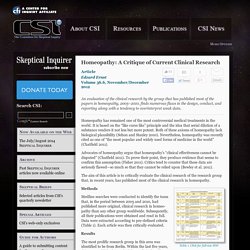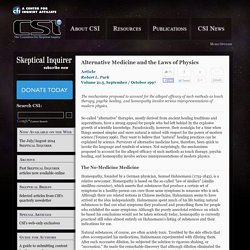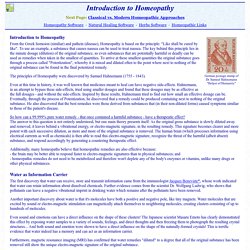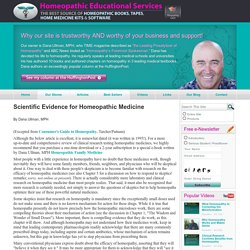

Homeopathy: A Critique of Current Clinical Research. Article Edzard Ernst Volume 36.6, November/December 2012 An evaluation of the clinical research by the group that has published most of the papers in homeopathy, 2005–2010, finds numerous flaws in the design, conduct, and reporting along with a tendency to overinterpret weak data.

Homeopathy has remained one of the most controversial medical treatments in the world. It is based on the “like cures like” principle and the idea that serial dilution of a substance renders it not less but more potent. Advocates of homeopathy argue that homeopathy’s “clinical effectiveness cannot be disputed” (Chatfield 2011). The aim of this article is to critically evaluate the clinical research of the research group that, in recent years, has published most of the clinical research in homeopathy. Methods Medline searches were conducted to identify the team that, in the period between 2005 and 2010, had published more original, clinical research in homeopathy than any other group worldwide.
Results Discussion. Alternative Medicine and the Laws of Physics. Article Robert L.

Park Volume 21.5, September / October 1997 The mechanisms proposed to account for the alleged efficacy of such methods as touch therapy, psychic healing, and homeopathy involve serious misrepresentations of modern physics. So-called “alternative” therapies, mostly derived from ancient healing traditions and superstitions, have a strong appeal for people who feel left behind by the explosive growth of scientific knowledge. The No-Medicine Medicine Homeopathy, founded by a German physician, Samuel Hahnemann (1755-1843), is a relative newcomer. Natural substances, of course, are often acutely toxic. Hahnemann actually made a third “discovery,” which his followers no longer mention. By means of successive dilutions, extremely dilute solutions can be achieved rather easily. An Introduction to Homeopathy. Introduction to Homeopathy From the Greek homoion (similiar) and pathein (disease), Homeopathy is based on the principle: "Like shall be cured by like".

To use an example, a substance that causes nausea can be used to treat nausea. The key behind this principle lies in the minute dosage (dilution) of the original substance, so even substances that are potentially harmful or deadly can be used as remedies when taken in the smallest of quantities. To arrive at these smallest quantities the original substance goes through a process called "Potentization", whereby it is mixed and diluted often to the point where next to nothing of the original substance can be found in the final potentized remedy. The principles of Homeopathy were discovered by Samuel Hahnemann (1755 - 1843). Even at this time in history, it was well known that medicines meant to heal can have negative side-effects. So how can a 99.999% pure water remedy - that once contained a harmful substance - have a therapeutic effect? Scientific Evidence for Homeopathic Medicine. By Dana Ullman, MPH (Excepted from Consumer's Guide to Homeopathy, Tarcher/Putnam) Although the below article is excellent, it is somewhat dated (it was written in 1995!).

For a more up-to-date and comprehensive review of clinical research testing homeopathic medicines, we highly recommend that you purchase a one-time download or a 2-year subscription to a special e-book written by Dana Ullman, MPH Homeopathic Family Medicine Most people with a little experience in homeopathy have no doubt that these medicines work, though inevitably they will have some family members, friends, neighbors, and physicians who will be skeptical about it.
One way to deal with these people's skepticism is to become familiar with research on the efficacy of homeopathic medicines (see also Chapter 5 for a discussion on how to respond to skeptics' remarks; sorry, not online at present). The two phases of a drug's action (thus the name "biphasic") are dose-dependent. Science vs Homeopathic Pseudoscience. Science is a philosophy, a technology, and an institution.

It is a human endeavor- our collective attempt to understand the world around us, not something that exists solely in the abstract. All of these aspects of science have be progressing over the past decades and centuries, as we refine our concepts of what science is and how it works, as we develop better techniques, and organize and police scientific activities more effectively. The practice of science is not relentlessly progressive, however, and there are many regressive forces causing pockets of backsliding, and even aggressive campaigns against scientific progress. So-called complementary and alternative medicine (CAM) is one such regressive force. It seeks to undermine the concepts, execution, and institutions of medical science in order to promote sectarian practices and ideological beliefs.
Ullman’s article is typically full of anecdotes, cherry picked evidence, and tortured logic. Radiation damages and kills cells. Fun with homeopaths and meta-analyses of homeopathy trials. Homeopathy amuses me.

Well, actually it both amuses me and appalls me. The amusement comes from just how utterly ridiculous the concepts behind homeopathy are. Think about it. It is nothing but pure magical thinking. Indeed, at the very core of homeopathy is a concept that can only be considered to be magic. At the same time, homeopathy appalls me.